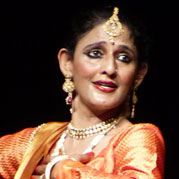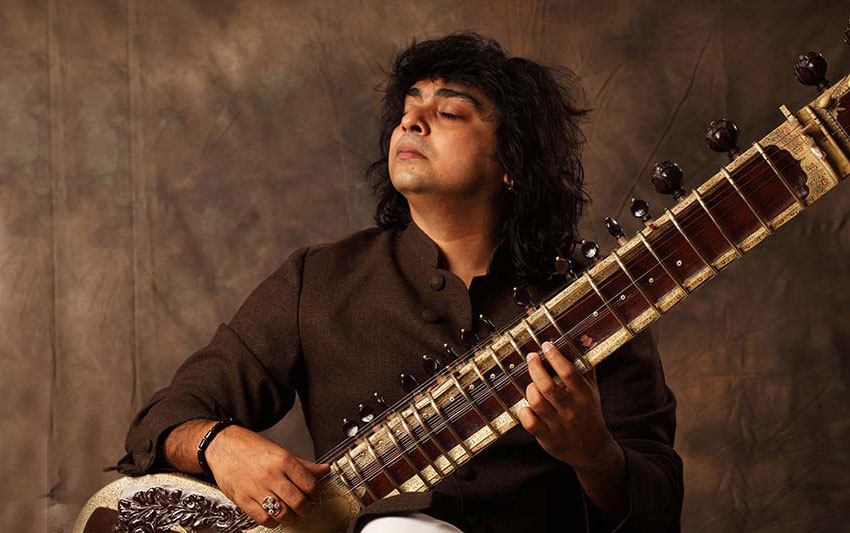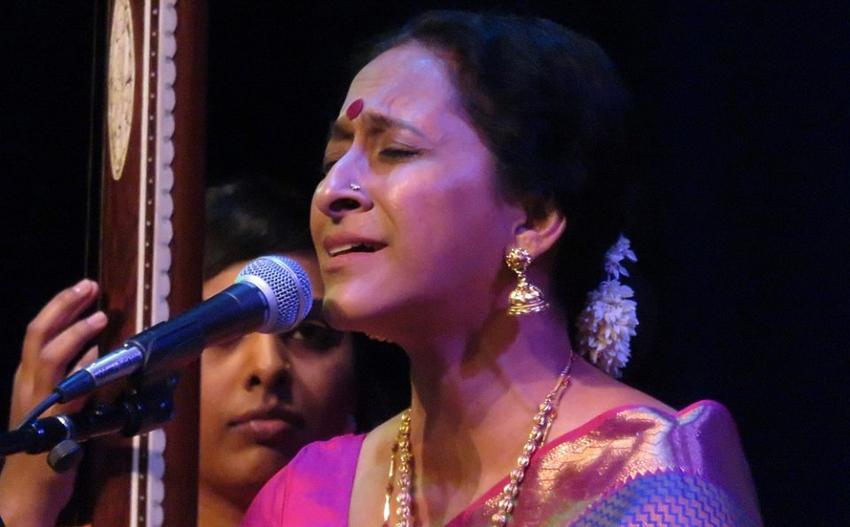Heroes born as history makers yield the past
With conquest to invoke for the present – Xaela San
Contemporary is embedded in Tradition
“It is the ignorant and the ego that makes artists trained in traditional arts in India say that they are doing something new. It is also the same ignorance that leads them to falsely believe that their contemporary is some fanciful new shop. No! The contemporary will fall if not the complex root system of the tradition. The old wine is old, just an eye that looks at the bottle from the lens of present time and space!” – Dr. Premlata Sharma, Musicologist, and Former Vice-chairman Sangit Natak Akademi
The name of legendary Pandit Birju Maharaj is synonymous with creating landmarks in the field of performing arts. A matchless wizard who comprehends time and space in sound, rhythm, and movement. Maharaj Ji (the Emperor) as he is popularly known is a dancer, choreographer, singer, and composer and can play several instruments. He paints and he writes.
A three-day (6th -8th December 2019 ) event at the Indira Gandhi National Centre for the Arts, New Delhi under a series called Diksha: Guru Shishya Parampara will showcase a body of work by Pt. Birju Maharaj. The works will be a huge statement that contemporary is embedded in Tradition.
One can critique that the comprehension of the idea of ‘Guru-Shishya’ actually undercuts the manner the audience enters the world of creativity of such a legend. The three-day festival will provide the audience to experience the manner the legend works with the science, philosophy and artistic beauty of rhythm, sound, and movements. The three-day retrospective is going to provide in the scholarly space of the Indira Gandhi Centre for the Arts a moment to think and reflect the tradition of Kathak through the work of a living legend.
What to Watch For:
The Philosophy of Rhythmic Patterns in Dance:
A simple repetitive mantra from Maharaj Ji is, “Everything around the world is rhythm. Rhythm is life, as much as it is poetry. Rhythm is designed in time and space and it is breath.” The quest for abstract mathematics in time and space is understood in such an intricate manner, that Pt. Birju Maharaj was able to dialogue with masters of rhythm such as Tabla Wizard Pt. Kishan Maharaj, Ustad Zakir Hussain as much with leagues of South Indian percussionists. Once Pt. Kishan Maharaj in a conversation with the author in Banaras described Maharaji’s command on rhythm, “In North India, there are three masters of rhythm. Pandit Ravi Shanker, Kishan Maharaj (himself) and Pt. Birju Maharaj. Of us, all Pt. Birju Maharaj is the most superior. He understands the waves in which the design of rhythm are organized and move in time. He is a genius in the manner he is able to create personalities and characters of rhythmic patterns.” This can be experienced in the choreographic piece of Naad Gunjan and the percussion ensemble Taal Vadya Kacheri.
Naad Gunjan: Created during the series of the 1980s Festivals of India, the choreographic piece unravels the character of different percussions. Tabla, Pakhawaj, Dholak, Nagara, Dhuf, and Manjira. The genius of the piece lies in the manner Maharaj Ji has comprehended the distinct sound and character of each percussion, and the manner each sound converses with each other. The conversation and character of patterns of sounds braided in rhythmic patterns are then manifested as movements and choreographic design.
Cubism & Kathak- The Philosophical thought of Dance and History
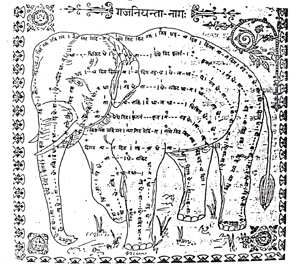
Naad Gunjan is in-fact representative of the style of cubist painting in motion. It serves to recall yet another such initiative of envisaging rhythm. This was an example illustrated in the court of the Patron King Chakradhar Maharaj (Raigarh Court – 1924-1947). The patron king Chakradhar Singh sent his court painter to Europe to explore the relation of representing North Indian Dance and Music in the form of paintings. There the painter Nanhelal Jani studied the post-impressionist painting movement by Cezanne. Cezanne as one knows influenced the Cubist painting movement of Picasso and Matisse. The painter returned to communicate the audiovisual idea of Kathak dance compositions and other percussion instruments primarily pakhawaj and tabla in illustrations. See below the sketch of Gajniyata Naga. In a margin noting of the court scribe, Chintamani Kashyap was a word written and signed by painter Nanhelal Jani. The small word written in Hindi read – Cezanne.
The sky calls for different sounds and it is with this in mind that the Naad-Gunjan can be both experienced and perceived.
When Sound becomes a Mosaic in Dance – Ghungaroo Sangeet
“An idea came to me to get special ghungaroos made to the tone of different musical notes. I then created the pentatonic scale Raga Bhopali in dance choreography,” described Birju Maharaj Ji in an interview with the author.
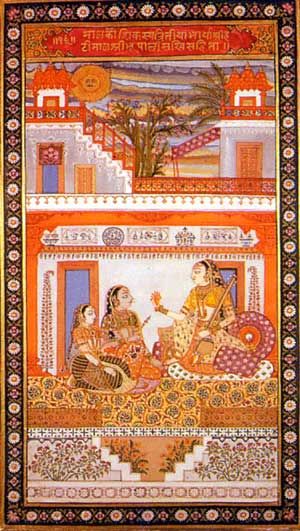
The five sounds of the Raga are played, sung and the raga comes alive. Five dancers representing five notes blend and move to produce the danced Raga. The character of the Raga and that of the musical notes is brought out in the selected journeys of movements and the placement of lines of the dancing arrangements. The recreation of the Raga Bhopali in dance is nothing short of genius. The idea of sound, the musicality of movements is intricately woven to bring out the rasa (emotive mood) of the evening meditative Raga.
The Ghuangaroo Sangeet interestingly creates an echo of yet another chapter in the history of Kathak. Nasir-Uddin Shah the Nawab of Lucknow created a production on Raga Bhairavi. The production like a renaissance theatre went on for several days. Each aspect of the character of the Raga was recreated.
Poetics and the Mood: – Thumri Malika – Garland of thumris
The North Indian Classical music genre of thumri remains fundamental to the emotive content of Kathak. Central to the mood of Kathak is the archetypal figure of Krishna – God, lover, child, and philosopher. Says the iconic Cultural persona – thinker, administrator, scholar, and dancer Dr. Kapila Vatsyayan, “In the oral history of the Kathak Dance, the dance is called Natwari – The dance of Krishna.” In the classic choreographic piece ‘Thumri Mallika’ Pt. Birju Maharaj Ji recreates a kind of minuscule Geet Govinda. The various women are metaphors of subconsciousness who strive to realize Krishna. The operatic format of the piece could very well be a contemporary version of the Rahas performed in the Lucknow court of Wajid Ali Shah or that of Raslila of Braj.
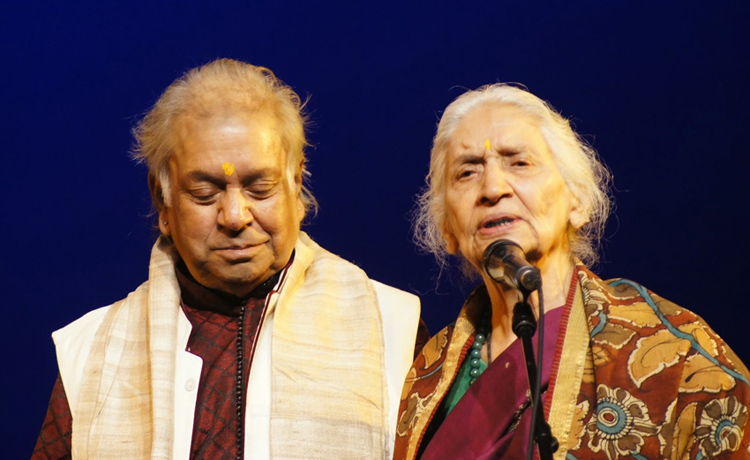
Countering the Phenomenon of Spectacles: The work of Pandit Birju is in contrast to the ‘contemporary’ Kathak. Today when Kathak is reduced to the loud wizardry of fast pirouettes, loud coverings in the form of design of light and sound, fashion-driven costumes. There is no stillness, or even an effort to comprehend the in-depth root systems that hold the tradition of the contemporary Kathak. In this loudness – The body of work of Pandit Birju Maharaj can stand alone – without fancy costumes, lights, sounds – Only and only the dance remains… A figure peeps from behind – Yes it is a Krishna – The Natwari!
Do Not Miss
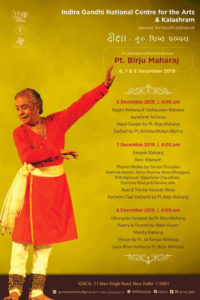
- Event: Diksha: Guru-Shishya Parampara
- Dates: 6th, 7th, 8th December
- Venue: Indira Gandhi National Centre for the Arts (IGNCA), New Delhi
Postscript: Ironical – It is ironical that Pt. Birju Maharaj was brought to Delhi by Dr. Kapila Vatsyayan. His lifetime work as a retrospective is presented at the Indira Gandhi Centre for the Arts- An institution conceived and founded by Dr. Vatsyayan.




